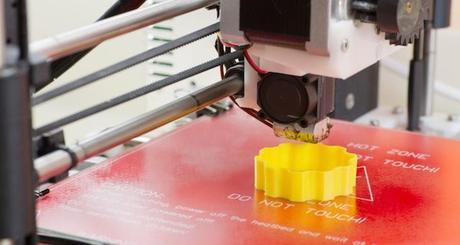
- September 17, 2014
- 0
- Email This Post
- Print This Post
3-D Printing Gains a Foothold with Brands
Don’t mistake it for a Star Trek Replicator; it’s a 3-D printer.
And this technology that can create tangible objects out of thin air is becoming a viable resource for manufacturers, fashion designers and design firms. Plus, large brands are starting to use the innovative technology in marketing to create personalized experiences for consumers.
The 3-D printing technology creates three-dimensional solid objects from digital models using a variety of materials from plastic and metal. Created in the late 1980s, the printers that once cost $30,000 are now priced closer to $1,000, making it more feasible for marketers to deploy the technology. In fact, the global market for 3-D printers is expected to grow more than 500 percent within the next five years as the technology becomes synonymous with everything from medicine to home goods, according to independent research company Canalys.
Several brands have experimented with the 3-D printing to create a personalized connection with their audiences, as reported by Kyle Montero for iMedia Connection.
Disney
Disney has been experimenting with the 3-D printing technology to enhance the Disney experience for Disney World park guests. The Mouse House launched an extension of its Princess Experience, the opportunity for female park guests to become a princess for the day within the park, by allowing Disney World visitors a chance to have their faces scanned to create mini Disney princess figurines. For the boys, Disney’s D-Tech Me scans their faces to allow them to own a personalized Star Wars action figure. The park lets guests choose between being a Storm Trooper or ending up encased in carbonite like Han Solo.
Coca-Cola
Coca-Cola introduced its new Mini Bottles in Israel with the use of a 3-D printing concept. The soda brand invited consumers to create tiny, digital versions of themselves in a branded mobile app. The goal was for consumers to tend to them carefully like mini-digital pets. A select few of those caretakers won a trip to the Coca-Cola factory, where they were invited to turn their digital selves into 3-D printed personalized action figures. The soda giant also partnered recently with the Black Eyes Peas’ Will.i.am to create the Ekocycle 3D printer, designed to use recycled soda bottles as material for 3-D printed objects.
DVV
Ashley Friedlein of Marketing Week wrote about a Belgian Insurance provider DVV that launched a service called Key Save, which lets customers scan their keys and save the data on a secure server. If they misplace the keys, they can 3-D print new ones. It’s a boon for forgetful customers and insurance companies as well, because insurers lose money yearly on replacing homeowners’ locks.
Nokia
Ad Age’s Ann-Christine Diaz profiled Nokia’s use of 3-D printing to promote the phone manufacturer’s latest smartphone, the Lumia 820. The company made 3-D printing kits available for customers to print out customized covers for their new smartphones at select retailers. The kit was part of the Nokia 3-D Printing Community Project, which supports Nokia’s customizable phones and its rainbow collection of removable faceplates.
At the moment, buyers of 3-D printers are mainly hobbyists and manufacturers, as opposed to the average consumer. Yet with its projected adoption rate, the printers might mimic the sales of the early computer, making it the must-have device in the next five years. Smart marketers could be part of the trend and the reason consumers feel the need to own a 3-D printer. As a marketer, it’s important to think about how your brand could become an integral part of the 3-D printing frenzy.
